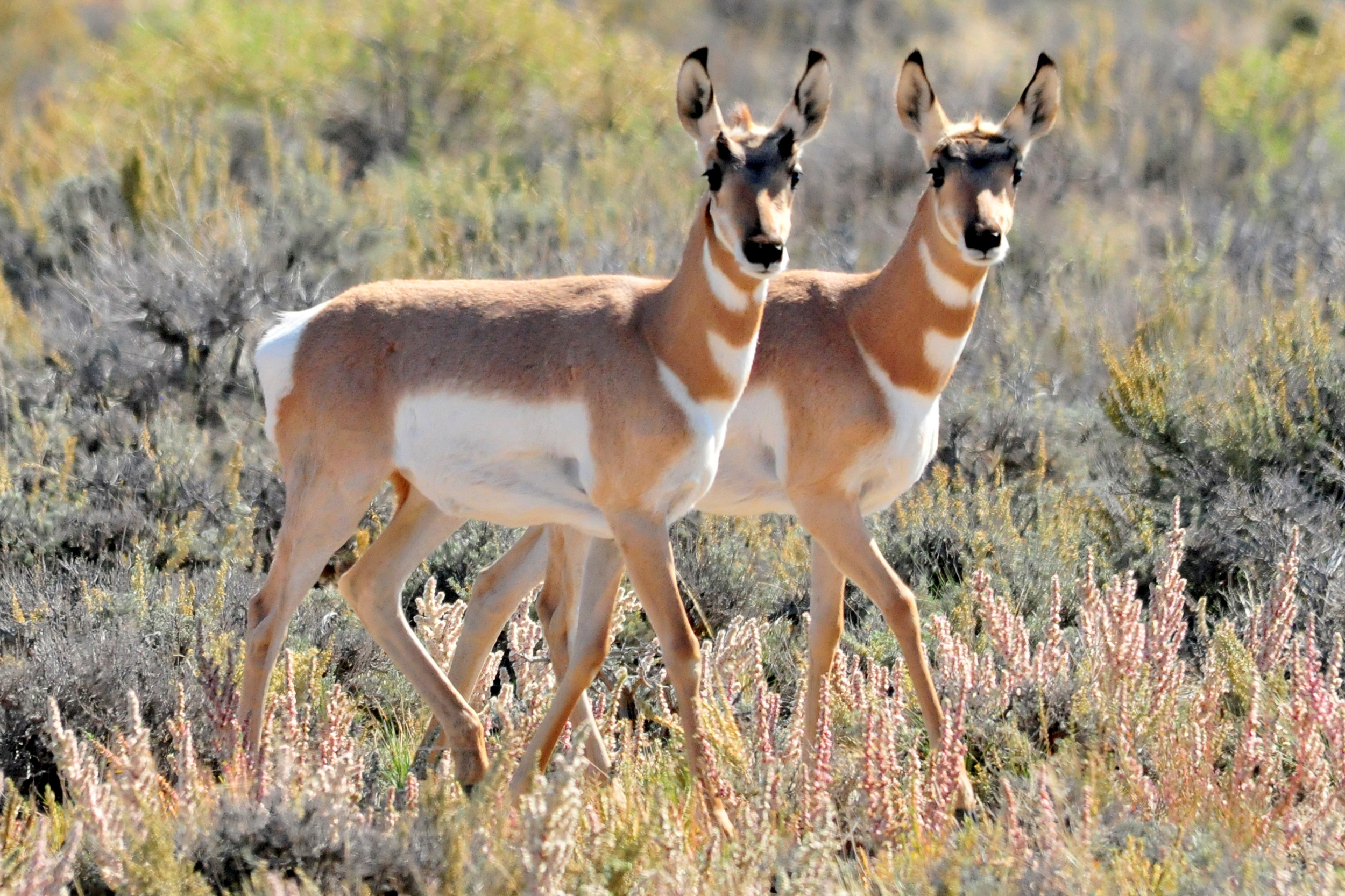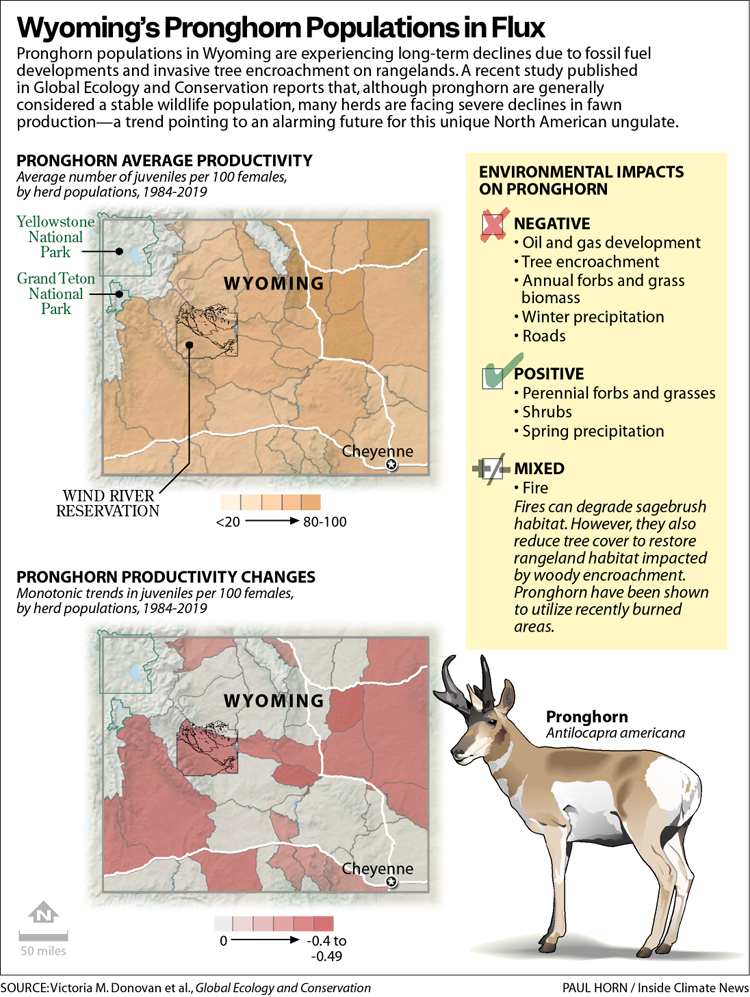Fossil Fuel Development and Invasive Trees Drive Pronghorn Population Decline in Wyoming
Pronghorn in Wyoming are experiencing long-term declines in the number of young they are rearing due to increased oil and gas development and encroaching woody vegetation, according to a new study. Although pronghorn populations in Wyoming have been largely stable, the new analysis shows that many herds are experiencing long-term declines in fawn production.
A group of researchers from four universities and the USDA’s Northern Plains Agricultural Research Laboratory analyzed a dataset collected by the Wyoming Game and Fish Department between 1984 and 2019 using aerial and ground surveys of the established migration routes of 40 herds in the state.
The findings were published in the journal Global Ecology and Conservation in April.
“Two major factors stood out: the density of oil and gas wells and the increase in tree cover within these 40 herd units,” said Jeff Beck, co-author of the study and a professor in the Department of Ecosystem Science and Management at the University of Wyoming. “As the landscape has changed with more trees and an increasing number of oil and gas wells, pronghorn productivity has consistently declined.”
Explore the latest news about what’s at stake for the climate during this election season.
The study also examined other factors, such as yearly plant and grassland coverage and biomass, wildfires, roads and increased winter precipitation, but found they were not significant drivers of the long-term declines in fawn births.
“They did a great job capturing work from other places and using that as a model for the Powder River Basin area,” said Joel Berger, a senior scientist with the Wildlife Conservation Society and a Chair of Wildlife Conservation at Colorado State University. “The study went deep, examining long-term trends rather than just a snapshot of what’s happening with pronghorn,” said Berger, who has extensively studied Mountain West Wildlife and was not involved in the study.
The unique ungulates that are both the fastest land animals in North America and the farthest migrating in the U.S. are native to Wyoming, which currently hosts around 40 to 50 percent of the world’s population. According to the Wyoming Game and Fish Department, the state has about 500,000 pronghorn. Typically considered a fertile species, female pronghorn usually have their first fawns at age two and can produce 20 to 30 offspring over their lifetimes, according to Beck. A highly productive pronghorn population has between 75 and 100 juveniles per 100 females—or even more, due to twins, triplets or quadruplets.In Wyoming, pronghorn fawns are usually born in late May and early June. Many die in their first two months, felled by predators. Those that survive face threats from hunting and food shortages.
That’s why herds need to keep reproducing.
“If pronghorn numbers decline, such as after a harsh winter or a drought, they usually rebound pretty quickly because of their high productivity rate,” Beck said.

The declining fawn-to-female ratios the new study identified over a wide geographic area suggest pronghorn populations are becoming less resilient to environmental disturbances. While pronghorn are widely distributed throughout Wyoming, the western side of the state saw significant losses in a severe winter two years ago. While populations in central and southeastern Wyoming did not fall as steeply during that winter, they have also been in decline during the past couple of decades.
“The pronghorn populations are not as resilient as they once were, which is a major concern,” said Rich Guenzel, an advocate for pronghorn conservation and a former wildlife biologist with the Wyoming Game and Fish Department. “Our current efforts to mitigate the impacts of development are simply not sufficient under present conditions.”
Fossil Fuel Development Obstructs Migration
Wyoming ranked eighth nationally in crude oil production in 2020 and saw a sevenfold increase in natural gas production from 1978 to its peak in 2010, according to the Wyoming State Geological Survey. Expansive increases in oil and gas development are a well-known threat to rangeland ecosystems in Wyoming, driving declines in iconic species like the greater sage-grouse, Beck said. For pronghorns, habitat fragmentation caused by oil and gas development has been linked to declines in population productivity by confining the herds, which migrate long distances between their winter and summer ranges, to smaller, more isolated patches.
The study found that 95% of the pronghorn herds that were studied have seen more oil and gas wells in their habitats.
“Pronghorn are adapted to rangelands and open landscapes. The oil and gas wells create disruptions in their movement and they avoid those areas,” Beck said. That significantly decreases the amount of territory available to the pronghorns throughout the state.
Although rules exist to protect wildlife in certain areas, industries can still develop within migration corridors, said Lee Knox, a senior wildlife biologist with the Wyoming Game and Fish Department.
“Wyoming prioritizes energy development,” he said. “We have certain stipulations that restrict activity during specific times, but they still can put in the infrastructure.”
While fossil fuel developments were identified as the biggest driver of the declining populations over the 35 years studied, green energy projects like solar and wind farms have recently started creating barriers in pronghorn habitats too, Knox noted. Citing a 2022 study, he emphasized that without stringent laws prioritizing wildlife, energy projects, regardless of type, typically get the right of way.

“One of the biggest issues affecting pronghorn now is wind and solar energy projects. We’ve seen instances where solar farms have blocked migration routes,” he said. “We still have low pronghorn populations, and we’re losing habitat annually due to increased subdivisions and energy development, whether it’s oil, gas, wind or solar.”
In addition to setting rules about development in migration corridors, the agency constructs wildlife overpasses and establishes buffers around critical wildlife habitat areas to prioritize conservation over energy development in certain pronghorn ranges. However, Knox believes these measures are inadequate.
“We’ve always taken pronghorn for granted. But as the study shows, if this continues, the population might decrease even more,” he said.
Trees Squeezing the Range
The study reveals that 70 percent of pronghorn face habitat barriers from tree species encroaching into their ranges. Different species of junipers and ponderosa pines are among the trees spreading into Wyoming’s grasslands.
While Beck said the spread of the conifers in Wyoming is less severe than in the Great Basin and Colorado Plateau, it’s significantly impacting pronghorn habitat.
“Rangelands that once had sparse tree cover are now experiencing a notable increase in density and expansion of small juniper trees, rapidly altering the landscape,” he said.
“When trees invade rangelands, it changes from habitat to non-habitat for true rangeland-adapted species,” he added, noting that the spread of the trees impacted other species in the ecosystem, like sage-grouse.
While the study did not explore the reasons behind the increasing tree cover, experts suggest fire suppression and drier conditions due to climate change likely play roles. Historically, wildfires would have burned back encroaching trees and slowed their spread, said Guenzel, the pronghorn conservation advocate. But human developments like roads, reservoirs and subdivisions, along with fire prevention and suppression efforts, have radically reduced the amount of wildfire on the landscape and their natural controls on spreading trees and thickening forests.
“What surprised me most was understanding the significant impact of tree cover on pronghorn abundance,” Guenzel said.
Beck suggested tree removal as a potential solution, but Knox cautioned that cutting or burning juniper trees could harm sagebrush and other shrub species critical to sage-grouse habitat.
“Cutting or mowing the juniper trees could be a solution, but it’s a very expensive process,” Knox said. “You could burn them, but then you’re setting back the sagebrush community at least 40 years.”
Despite these challenges, Knox highlighted the study’s findings as a call for wildlife managers to develop comprehensive strategies to manage conifer encroachment for the benefit of multiple species in the future.
Saving a Keystone of the State’s Identity and Economy
Pronghorn are a particular source of pride for Wyoming residents and play a crucial role in the state’s hunting economy. Outdoor recreation makes up 4.1 percent of the state’s economy, according to the Gross Domestic Product by State 2023 report of the U.S. Department of Commerce’s Bureau of Economic Analysis. A significant portion of the approximately $2.2 billion the industry generates annually is attributed to hunting.
According to Beck, a decline in pronghorn could lead to cuts in the number of hunting permits issued by the state in order to maintain their population levels. “If productivity doesn’t rebound, we may see fewer hunting opportunities in the future,” Beck said.
“Our agencies prioritize wildlife conservation, but objections from the oil and gas industry hinder these efforts.”
In light of the new study, experts stress the importance of migration corridors and open rangelands that allow pronghorn to travel unhindered.
“Our folks sometimes use an expression called ‘freedom to roam’ and pronghorn need that,” said Guenzel, who emphasized the urgency of addressing declining pronghorn populations. But some conservationists say wildlife managers face challenges in speaking openly about realities on the ground for wildlife, especially regarding conflicts with fossil fuel industries.
“Our agencies prioritize wildlife conservation, but objections from the oil and gas industry hinder these efforts,” Guenzel said.
“There needs to be better discussions among Wyoming legislators, who take pride in their wildlife and natural resources, including gas and oil,” said Berger. “If we aim to conserve wildlife, including bolstering pronghorn populations, the state must take more proactive steps.”
About This Story
Perhaps you noticed: This story, like all the news we publish, is free to read. That’s because Inside Climate News is a 501c3 nonprofit organization. We do not charge a subscription fee, lock our news behind a paywall, or clutter our website with ads. We make our news on climate and the environment freely available to you and anyone who wants it.
That’s not all. We also share our news for free with scores of other media organizations around the country. Many of them can’t afford to do environmental journalism of their own. We’ve built bureaus from coast to coast to report local stories, collaborate with local newsrooms and co-publish articles so that this vital work is shared as widely as possible.
Two of us launched ICN in 2007. Six years later we earned a Pulitzer Prize for National Reporting, and now we run the oldest and largest dedicated climate newsroom in the nation. We tell the story in all its complexity. We hold polluters accountable. We expose environmental injustice. We debunk misinformation. We scrutinize solutions and inspire action.
Donations from readers like you fund every aspect of what we do. If you don’t already, will you support our ongoing work, our reporting on the biggest crisis facing our planet, and help us reach even more readers in more places?
Please take a moment to make a tax-deductible donation. Every one of them makes a difference.
Thank you,
David Sassoon
Founder and Publisher
Vernon Loeb
Executive Editor
Share this article
Disclaimer: The copyright of this article belongs to the original author. Reposting this article is solely for the purpose of information dissemination and does not constitute any investment advice. If there is any infringement, please contact us immediately. We will make corrections or deletions as necessary. Thank you.
Title:Fossil Fuel Development and Invasive Trees Drive Pronghorn Population Decline in Wyoming
Url:https://www.investsfocus.com




